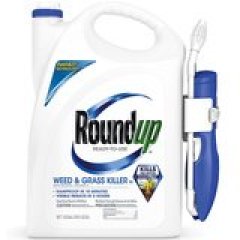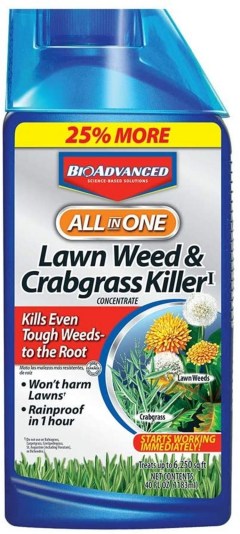Buying guide for best crabgrass killers
It creeps up unexpectedly. It grows in the cracks of your sidewalk and takes over your lawn. You can win the battle against crabgrass with the right kind of crabgrass killer and good timing. If you had just a couple of crabgrass weeds in your yard last year, they may have thrown literally hundreds of thousands of seeds on your lawn during the growing season. Those seeds will lie dormant all winter and begin to grow in early spring. You need to hit the crabgrass early and hit it hard with an effective crabgrass killer to keep control of your lawn.
If you want to see a green lawn in your future, here are some important things to consider before buying a crabgrass killer.
Types of crabgrass killers
There are two general types of crabgrass killers: pre-emergent herbicides and post-emergent herbicides.
Pre-emergent herbicides
You can use a pre-emergent herbicide to get a leg up on crabgrass before it even starts to grow. You put a pre-emergent herbicide on your lawn – often with a fertilizer – to damage the seeds and keep them from growing. Pre-emergent herbicides generally consist of both fertilizer and crabgrass killer. The product is usually granular in nature; you use a lawn spreader to apply it, and it must get wet before it will work.
The type of fertilizer that’s most effective varies by the season (fall vs. spring), but the crabgrass-killing component of the herbicide will generally be the same.
Post-emergent herbicides
Post-emergent crabgrass killers generally come in spray form. You can use them after you see crabgrass sprouting in your lawn.
These sprays often come with a variety of other weed killers mixed in, promising to kill broadleaf weeds like dandelions or clover in addition to your crabgrass.
Unlike pre-emergent crabgrass killers, you will want to make sure the forecast is dry before application. Even the wet dew of the morning will dilute the effectiveness of a post-emergent herbicide.
Did you know?
Atmospheric temperature is an important factor in the effectiveness of post-emergent crabgrass killers. If the temperature is too high, the chemical will be absorbed too quickly to be effective.
STAFF
BestReviews
A note about chemicals
There is no getting around chemicals if you’re trying to get rid of weeds like crabgrass. Crabgrass killers on the market use a lot of different chemicals that provide decent control of the weed. Some examples of chemicals included in crabgrass killers include the following.
-
Dithiopyr: This is an pre-emergent crabgrass killer. It works by inhibiting cell development in the plants. It has the advantage of being less irritating to human hands and eyes and is not expected to harm birds. If you live near a waterway, you may want to consider that products with dithiopyr have been proven harmful to fish.
-
Prodiamine: This chemical is found in pre-emergent crabgrass killer products. It is considered a flexible chemical that works well in both fall and spring. Products with prodiamine are thought to do a better job controlling crabgrass all season long.
-
Pendimethalin: This chemical works well in both pre-emergent and post-emergent applications. It prevents crabgrass growth by inhibiting cell division.
-
Quinclorac: This chemical is commonly used by professionals to control crabgrass, especially on golf courses and at sports complexes. It works by suppressing plant hormones.
-
Fluazifop-P-butyl: This post-emergent herbicide chemical is designed to be safe for broadleaf plants. Products containing it are best used in landscaping to protect ornamental plants rather than entire lawns. It works on annual plants like crabgrass and perennial grasses. It’s great for controlling crabgrass as it grows horizontally along the ground.
-
Glyphosate: This chemical works on growing weeds and plants. It’s the active ingredient in many leading crabgrass killers and can effectively kill weeds mid-season. Importantly, glyphosate is a slow-acting agent. It takes several days or even a week to see results. However, it is very effective.
Application methods
There are two primary ways to apply crabgrass killers on your lawn. Your method will likely depend on the type of herbicide you use. Always follow the application guidelines on the packaging closely.
Spray
Spray applicators allow you to closely target the crabgrass you can already see growing in your lawn. Some products come with a spray applicator. Others will require you to have your own.
Pellet spreaders
Pre-emergent crabgrass killers will likely come in a form that requires the use of a spreader. You can use the same type of spreader that you’d use to spread seed.
In both application methods, it is important to wear proper protection. Gloves, a mask, and goggles are critical gear. After application, you will want to thoroughly clean your applicators and any protective gear you may have worn during the application.
Caution
In order to avoid chemical drifting, which can increase the environmental danger of using herbicides, make sure you do not spray crabgrass killer on a windy day.
STAFF
BestReviews
Crabgrass killer prices
When pricing crabgrass killers, you will first need to estimate the square footage of the grass or landscaping you wish to treat.
You can find some good-quality post-emergent crabgrass killers in this price range.
Pre-emergent herbicides which can be applied when you apply fertilizer can be purchased at this approximate cost. These herbicides often come mixed with fertilizer. So, although the price point is higher, you are also getting a good feeding product for your lawn.
Did you know?
Crabgrass killers are made from chemicals that require environmentally safe disposal.
STAFF
BestReviews
Tips
-
Leave the last fall cutting of your lawn a little higher than usual. Most weeds, like crabgrass, come out of dormancy a bit earlier in the season than lawn grasses. Taller surrounding grass makes it harder for those weeds to find the sun in the spring.
-
Despite its reappearance year to year in your yard, crabgrass is an annual weed, not a perennial one. If you get it out before it grows in the early spring, you are more likely to keep it from becoming a problem all season. When you see the first flowers of spring start to bloom, you know that the crabgrass has started to germinate. It is time to treat your lawn for it.
-
Like most weed killers on the market, crabgrass killers are not organic. Most are considered safe for humans to touch after they dry.
-
Check the recommended temperature range before applying your crabgrass killer. Crabgrass killers perform best when the atmosphere is within a certain temperature range. Post-emergent crabgrass killers do not work well below 60°F or over 85°F. (At lower temperatures, the weed may be growing too slowly to be affected. At higher temperatures, the crabgrass killer may kill the other grasses in your lawn.) Pre-emergent crabgrass killer can generally be applied after temperatures stay above 70°F and flowering plants begin to bloom in your area. They can be used in either spring or fall.
-
Apply pre-emergent herbicide right before it rains, or if you prefer, plan to water your lawn immediately after its application. The best time to apply a pre-emergent crabgrass killer is in the fall, at the same time you apply a high nitrogen fertilizer. These two components can be found mixed together and can be applied in the same application.
-
Give the crabgrass killer time to work. You will need to wait several days, or even weeks, before you see the full effects of your crabgrass killer application.
-
Consider re-applying crabgrass killer mid-way through the growing season. This is an extra measure you can take to help keep the crabgrass under control.
-
Take care that you do not damage healthy turf or soil. Before you choose a crabgrass killer, carefully check the formula to make sure it will not also take out the grass you want to thrive in your lawn.
FAQ
Q. Is crabgrass killer safe for my family?
A. Crabgrass killers contain chemicals that could be harmful to humans if misused. With heavy use, some chemicals have been linked to cancer in humans. However, they are considered safe if used properly.
Keep crabgrass killer out of the hands of children, and read all of the instructions on the application bottle before use. Dilute it properly, and only mix as much as you believe you will need for one application.
It is usually considered safe for a human to be on a lawn after a spray-on crabgrass killer has thoroughly dried. However, you should always check the directions on your particular product for confirmation of this.
Q. How do I know I have crabgrass?
A. Crabgrass blades are about 1/4-inch wide, and the blades appear farther apart than those of other grasses. Crabgrass tends to grow outward rather than upward, with shoots spurring off from a center growth spot. Some describe the pattern of growth as a kind of star-like pattern.
Crabgrass comes in a variety of green shades based on how much sun it is getting. Smaller versions of the plant can be hard to spot amongst normal lawn grass.
Q. Will a crabgrass killer eradicate other weeds?
A. Yes. Most post-emergent crabgrass killers are designed to kill a variety of weeds. It is important to check the labeling to make sure the crabgrass killer you choose for your landscaping will not pose a threat to the plants and grasses you want to keep around.



























